国际经济学全英论文
- 格式:doc
- 大小:68.50 KB
- 文档页数:7
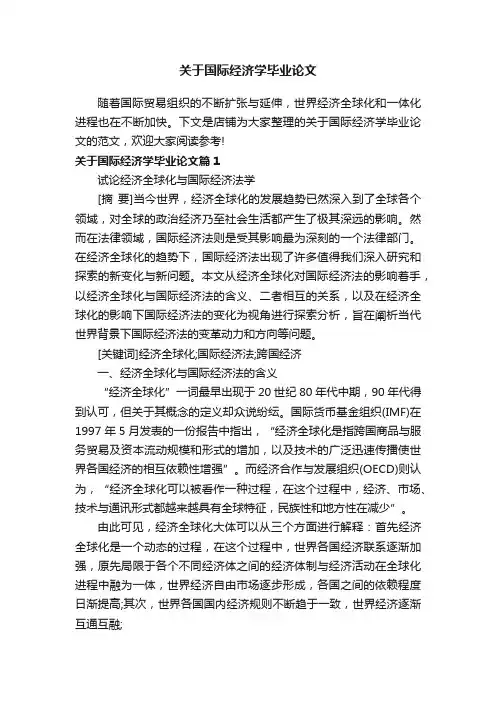
关于国际经济学毕业论文随着国际贸易组织的不断扩张与延伸,世界经济全球化和一体化进程也在不断加快。
下文是店铺为大家整理的关于国际经济学毕业论文的范文,欢迎大家阅读参考!关于国际经济学毕业论文篇1试论经济全球化与国际经济法学[摘要]当今世界,经济全球化的发展趋势已然深入到了全球各个领域,对全球的政治经济乃至社会生活都产生了极其深远的影响。
然而在法律领域,国际经济法则是受其影响最为深刻的一个法律部门。
在经济全球化的趋势下,国际经济法出现了许多值得我们深入研究和探索的新变化与新问题。
本文从经济全球化对国际经济法的影响着手,以经济全球化与国际经济法的含义、二者相互的关系,以及在经济全球化的影响下国际经济法的变化为视角进行探索分析,旨在阐析当代世界背景下国际经济法的变革动力和方向等问题。
[关键词]经济全球化;国际经济法;跨国经济一、经济全球化与国际经济法的含义“经济全球化”一词最早出现于20世纪80年代中期,90年代得到认可,但关于其概念的定义却众说纷纭。
国际货币基金组织(IMF)在1997年5月发表的一份报告中指出,“经济全球化是指跨国商品与服务贸易及资本流动规模和形式的增加,以及技术的广泛迅速传播使世界各国经济的相互依赖性增强”。
而经济合作与发展组织(OECD)则认为,“经济全球化可以被看作一种过程,在这个过程中,经济、市场、技术与通讯形式都越来越具有全球特征,民族性和地方性在减少”。
由此可见,经济全球化大体可以从三个方面进行解释:首先经济全球化是一个动态的过程,在这个过程中,世界各国经济联系逐渐加强,原先局限于各个不同经济体之间的经济体制与经济活动在全球化进程中融为一体,世界经济自由市场逐步形成,各国之间的依赖程度日渐提高;其次,世界各国国内经济规则不断趋于一致,世界经济逐渐互通互融;再次,为了构建和谐的世界经济体制,国际经济协调机制日益强化,各种多边或区域组织对世界经济的约束与规制日益显著。
总的来讲,经济全球化是指以市场经济为基础,以先进科技和生产力为手段,以发达国家为主导,以最大利润和经济效益为目标,通过分工、贸易、投资、跨国公司和要素流动等,实现各国市场分工与协作,相互融合的动态过程。
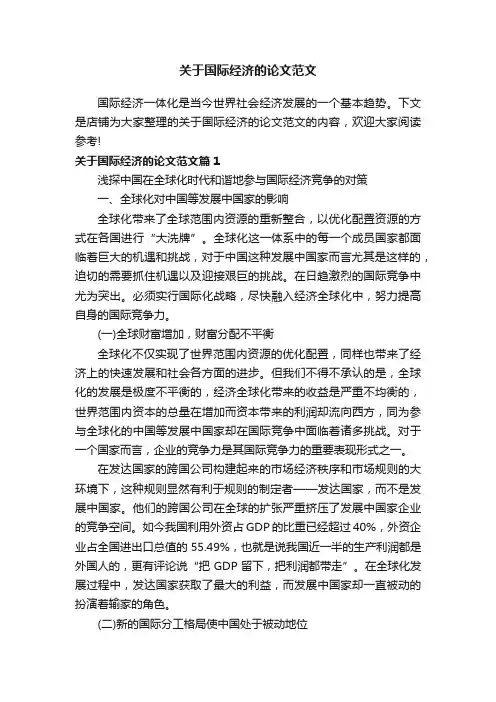
关于国际经济的论文范文国际经济一体化是当今世界社会经济发展的一个基本趋势。
下文是店铺为大家整理的关于国际经济的论文范文的内容,欢迎大家阅读参考!关于国际经济的论文范文篇1浅探中国在全球化时代和谐地参与国际经济竞争的对策一、全球化对中国等发展中国家的影响全球化带来了全球范围内资源的重新整合,以优化配置资源的方式在各国进行“大洗牌”。
全球化这一体系中的每一个成员国家都面临着巨大的机遇和挑战,对于中国这种发展中国家而言尤其是这样的,迫切的需要抓住机遇以及迎接艰巨的挑战。
在日趋激烈的国际竞争中尤为突出。
必须实行国际化战略,尽快融入经济全球化中,努力提高自身的国际竞争力。
(一)全球财富增加,财富分配不平衡全球化不仅实现了世界范围内资源的优化配置,同样也带来了经济上的快速发展和社会各方面的进步。
但我们不得不承认的是,全球化的发展是极度不平衡的,经济全球化带来的收益是严重不均衡的,世界范围内资本的总量在增加而资本带来的利润却流向西方,同为参与全球化的中国等发展中国家却在国际竞争中面临着诸多挑战。
对于一个国家而言,企业的竞争力是其国际竞争力的重要表现形式之一。
在发达国家的跨国公司构建起来的市场经济秩序和市场规则的大环境下,这种规则显然有利于规则的制定者——发达国家,而不是发展中国家。
他们的跨国公司在全球的扩张严重挤压了发展中国家企业的竞争空间。
如今我国利用外资占GDP的比重已经超过40%,外资企业占全国进出口总值的55.49%,也就是说我国近一半的生产利润都是外国人的,更有评论说“把GDP留下,把利润都带走”。
在全球化发展过程中,发达国家获取了最大的利益,而发展中国家却一直被动的扮演着输家的角色。
(二)新的国际分工格局使中国处于被动地位随着高新技术产业的发展,发达国家把核心技术以及生产方式保留在国内,而把毫无技术含量、单纯消耗资源和劳动力的生产过程放到各个发展中国家。
使得这些发展中国家在全球化竞争中毫无竞争力可言,虽然参与其中却无法与以核心技术为资本的发达国家竞争,造成发展中国家在核心技术上越来越依赖发达国家。
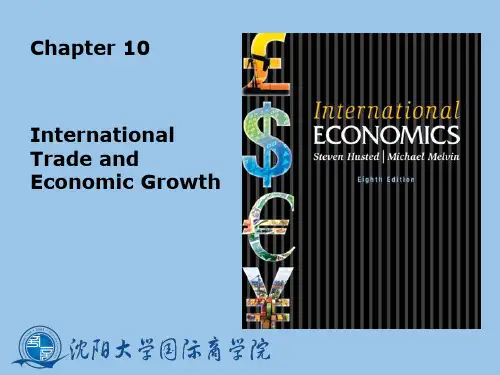
![国际经济学2演讲和论文题目[5篇]](https://uimg.taocdn.com/45b3102977c66137ee06eff9aef8941ea76e4b36.webp)
国际经济学2演讲和论文题目[5篇]第一篇:国际经济学2演讲和论文题目国际经济学2演讲和论文题目1.What do you think is the major problem of US international balance of payments? Pleaseanalyze the possible reasons for this imbalance?2.What do you think is the major problem of China’s international balance of payments? Pleaseanalyze the possible reasons for this imbalance?3.What’s the meaning of arbitrage? What’s difference between exchange arbitrage andinterest arbitrage? If you’re a dealer in foreign exchange market, how do you use the forward market to cover the exchange-rate risk when you exercise an interest arbitrage? How do you speculate in the forward market? And finally, what’s the difference between arbitrage and speculation? Please present some real examples of speculation and express your opinion on its influence.4.Please explain the theory of “interest rate parity”.利率平价理论What is the differencebetween “covered” and “uncovered” interest rate parity? Demonstrate演示 the difference by formula公式 and tell us how to derive派生 this formula.In your paper, please apply this theory to predict RMB’s exchange rate against one major foreign currency.5.Please explain the theory of “purchasing power parity”.What is the difference between“absolute” and “relative” purchasing power parity? Demonstrate the difference by formula.Explain the mechanism of “big mac Index” and use this tool to predict RMB’s exchange rate against one major foreign currency in your paper.第二篇:演讲和感想伟大的演讲产生伟大的力量,它能够让人觉醒催人奋进,它能够震撼人们的灵魂,它能够粉粹人世间的丑恶,它能够将激扬人世间的美善,它能够改变人们的精神风貌,它甚至能够改变历史的进程。
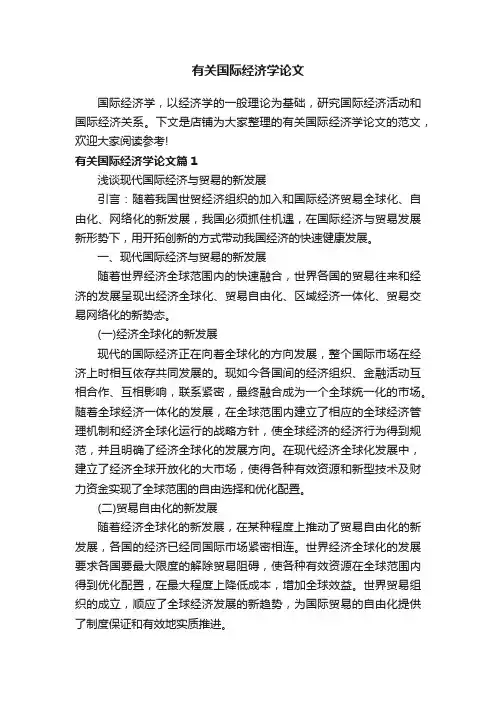
有关国际经济学论文国际经济学,以经济学的一般理论为基础,研究国际经济活动和国际经济关系。
下文是店铺为大家整理的有关国际经济学论文的范文,欢迎大家阅读参考!有关国际经济学论文篇1浅谈现代国际经济与贸易的新发展引言:随着我国世贸经济组织的加入和国际经济贸易全球化、自由化、网络化的新发展,我国必须抓住机遇,在国际经济与贸易发展新形势下,用开拓创新的方式带动我国经济的快速健康发展。
一、现代国际经济与贸易的新发展随着世界经济全球范围内的快速融合,世界各国的贸易往来和经济的发展呈现出经济全球化、贸易自由化、区域经济一体化、贸易交易网络化的新势态。
(一)经济全球化的新发展现代的国际经济正在向着全球化的方向发展,整个国际市场在经济上时相互依存共同发展的。
现如今各国间的经济组织、金融活动互相合作、互相影响,联系紧密,最终融合成为一个全球统一化的市场。
随着全球经济一体化的发展,在全球范围内建立了相应的全球经济管理机制和经济全球化运行的战略方针,使全球经济的经济行为得到规范,并且明确了经济全球化的发展方向。
在现代经济全球化发展中,建立了经济全球开放化的大市场,使得各种有效资源和新型技术及财力资金实现了全球范围的自由选择和优化配置。
(二)贸易自由化的新发展随着经济全球化的新发展,在某种程度上推动了贸易自由化的新发展,各国的经济已经同国际市场紧密相连。
世界经济全球化的发展要求各国要最大限度的解除贸易阻碍,使各种有效资源在全球范围内得到优化配置,在最大程度上降低成本,增加全球效益。
世界贸易组织的成立,顺应了全球经济发展的新趋势,为国际贸易的自由化提供了制度保证和有效地实质推进。
(三)现代区域经济一体化的新发展随着经济全球化和贸易自由化的发展,全球涌现出各种不同的区域经济一体化的经济组织,使现代区域经济向着一体化的方向发展。
(四)现代贸易交易网络化的新发展随着网络技术和知识经济的发展,现代贸易交易方式呈现出网络化的发展趋势,产生了新的网络贸易,即利用现代网络技术,借助电子信息平台进行商务活动和贸易交易,从贸易的洽谈到签约再到交货直至付款的整个交易过程都可以在网络上进行得以实现。
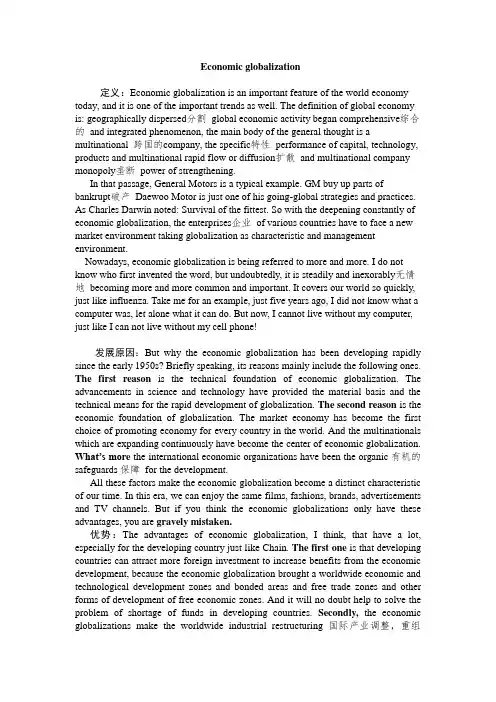
Economic globalization定义:Economic globalization is an important feature of the world economy today, and it is one of the important trends as well. The definition of global economyis: geographically dispersed分割global economic activity began comprehensive综合的and integrated phenomenon, the main body of the general thought is a multinational 跨国的company, the specific特性performance of capital, technology, products and multinational rapid flow or diffusion扩散and multinational company monopoly垄断power of strengthening.In that passage, General Motors is a typical example. GM buy up parts ofbankrupt破产Daewoo Motor is just one of his going-global strategies and practices. As Charles Darwin noted: Survival of the fittest. So with the deepening constantly of economic globalization, the enterprises企业of various countries have to face a new market environment taking globalization as characteristic and management environment.Nowadays, economic globalization is being referred to more and more. I do notknow who first invented the word, but undoubtedly, it is steadily and inexorably无情地becoming more and more common and important. It covers our world so quickly, just like influenza. Take me for an example, just five years ago, I did not know what a computer was, let alone what it can do. But now, I cannot live without my computer, just like I can not live without my cell phone!发展原因:But why the economic globalization has been developing rapidly since the early 1950s? Briefly speaking, its reasons mainly include the following ones. The first reason is the technical foundation of economic globalization. The advancements in science and technology have provided the material basis and the technical means for the rapid development of globalization. The second reason is the economic foundation of globalization. The market economy has become the first choice of promoting economy for every country in the world. And the multinationals which are expanding continuously have become the center of economic globalization. What’s mo re the international economic organizations have been the organic有机的safeguards保障for the development.All these factors make the economic globalization become a distinct characteristicof our time. In this era, we can enjoy the same films, fashions, brands, advertisements and TV channels. But if you think the economic globalizations only have these advantages, you are gravely mistaken.优势:The advantages of economic globalization, I think, that have a lot, especially for the developing country just like Chain. The first one is that developing countries can attract more foreign investment to increase benefits from the economic development, because the economic globalization brought a worldwide economic and technological development zones and bonded areas and free trade zones and other forms of development of free economic zones. And it will no doubt help to solve the problem of shortage of funds in developing countries. Secondly, the economic globalizations make the worldwide industrial restructuring国际产业调整,重组further, the pace of increase. Developing countries can take advantage of this opportunity with based on reality and focus on the future, and then take the initiative to coordinate the worldwide industrial restructuring and upgrading升级of domestic industries relationship. Thirdly, there are many advantages for the smaller business owners in developing countries, they can have more opportunities in expanding their companies globally, having more choices when recruiting招聘a workforce. More importantly, they gain an opportunity to target a larger customer base in the world. Lastly,I believe that the economic globalization would also help in promoting international cooperation and peace. If countries are dependent upon one another's economic success, economical and cultural conflicts among countries would be less likely occurring.短处:Although, there are numbers advantages of economic organizations, but every medal has two sides, so, we should not neglect the disadvantages of economic organizations. At first, through the economic globalizations and an open door policy, the erroneous concepts, the lowering of ethical standards, the selfish and individualistic lifestyle or even some harmful cultural products can easily be imported into the country. Additionally,during the process of economic globalization, inequality between developed and developing countries has been increasing and the gap between the rich and the poor has become wider. Besides these,the economic risks in economic globalization is unavoidable, as modern science and technology and economic globalization continue to develop, competition among countries has become fiercer than ever before, so the financial and economic risks are increasing, and economic security has become a concern for all countries. Such as the economic crisis in 2008 in the world. Therefore, even the economic organization make world become “global village”, we should also keep a cool head and should not imitate others mechanically.For China, after 15 years arduous efforts, we became a full member of the world trade organization in December 2001, which was a new landmark in our opening up and that is the vital step of participating in the economic organization. And in recent years, our nation takes a faster pace to open up to the outside world, and I believe thatwe will be more open and integrate into world economy.Economic globalization brings us not only a great challenge, but also a great chance to develop. If we can strengthen ourselves and take the chance, I believ e, China’s development will be hastened greatly, and China will become the leader of economic globalization of the world!。
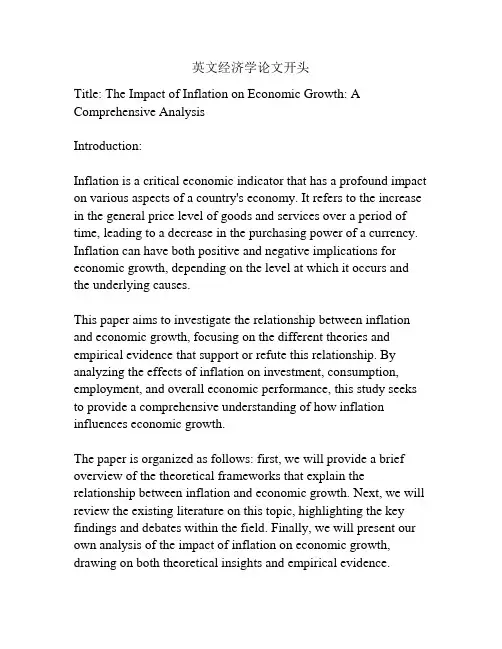
英文经济学论文开头Title: The Impact of Inflation on Economic Growth: A Comprehensive AnalysisIntroduction:Inflation is a critical economic indicator that has a profound impact on various aspects of a country's economy. It refers to the increase in the general price level of goods and services over a period of time, leading to a decrease in the purchasing power of a currency. Inflation can have both positive and negative implications for economic growth, depending on the level at which it occurs and the underlying causes.This paper aims to investigate the relationship between inflation and economic growth, focusing on the different theories and empirical evidence that support or refute this relationship. By analyzing the effects of inflation on investment, consumption, employment, and overall economic performance, this study seeks to provide a comprehensive understanding of how inflation influences economic growth.The paper is organized as follows: first, we will provide a brief overview of the theoretical frameworks that explain the relationship between inflation and economic growth. Next, we will review the existing literature on this topic, highlighting the key findings and debates within the field. Finally, we will present our own analysis of the impact of inflation on economic growth, drawing on both theoretical insights and empirical evidence.。
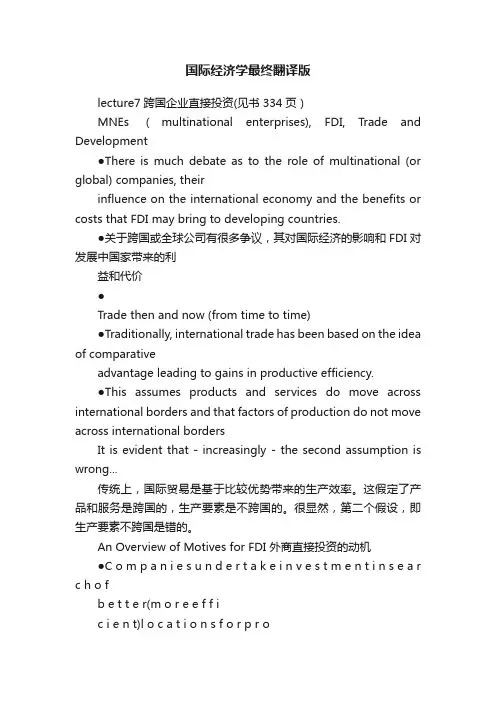
国际经济学最终翻译版lecture7跨国企业直接投资(见书334页)MNEs (multinational enterprises), FDI, Trade and Development●There is much debate as to the role of multinational (or global) companies, theirinfluence on the international economy and the benefits or costs that FDI may bring to developing countries.●关于跨国或全球公司有很多争议,其对国际经济的影响和FDI对发展中国家带来的利益和代价●Trade then and now (from time to time)●Traditionally, international trade has been based on the ide a of comparativeadvantage leading to gains in productive efficiency.●This assumes products and services do move across international borders and that factors of production do not move across international bordersIt is evident that - increasingly - the second assumption is wrong...传统上,国际贸易是基于比较优势带来的生产效率。
这假定了产品和服务是跨国的,生产要素是不跨国的。
很显然,第二个假设,即生产要素不跨国是错的。
An Overview of Motives for FDI 外商直接投资的动机●C o m p a n i e s u n d e r t a k e i n v e s t m e n t i n s e a rc h o fb e t t e r(m o r e e f f ic i e n t)l o c a t i o n s f o r p r od u c t i o n a n d/o r ne w m a r k e t sC o u n t r i e s s e e k i n w a r d i n v e s t m e n t f r o m M N E s b e c a u s e t h e y b e l i e v e i t w i l l b r i n g●f a s t e r e c o n o m i c g r o w t h,s k i l l t r a n s f e r s a n d a n i m p r o v e d B a l a n c e o f P a y m e n t s.●公司进行F D I是为了寻求更好/更有效率的生产地和新市场●国家寻求来自跨国公司的对内投资是为了:更快的经济增长,技术转移,国际收支平衡的改善●The Company Perspective公司的角度●Companies look to make profitable (well, potentially profitable) investments, so.●Company decisions are based on the interests of the company and its stakeholders.●Company decisions, therefore, can be analyzed and understood using the tools,theories and ideas of business strategy------companies involved in FDI are seeking increased efficiency in production and/ or new markets.●公司寻求可盈利(潜在利益)的投资,所以公司的决定是基于该公司和利益相关者的利益。
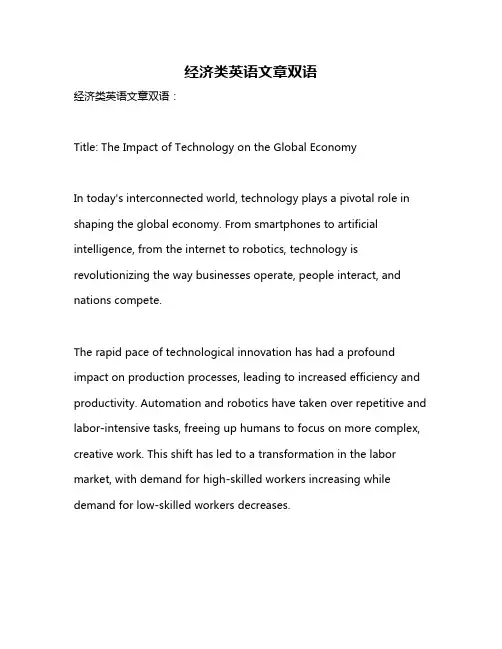
经济类英语文章双语经济类英语文章双语:Title: The Impact of Technology on the Global EconomyIn today's interconnected world, technology plays a pivotal role in shaping the global economy. From smartphones to artificial intelligence, from the internet to robotics, technology is revolutionizing the way businesses operate, people interact, and nations compete.The rapid pace of technological innovation has had a profound impact on production processes, leading to increased efficiency and productivity. Automation and robotics have taken over repetitive and labor-intensive tasks, freeing up humans to focus on more complex, creative work. This shift has led to a transformation in the labor market, with demand for high-skilled workers increasing while demand for low-skilled workers decreases.Technology has also reshaped the global trade landscape. The rise of e-commerce and digital platforms has made it easier for small and medium-sized enterprises to access global markets, leveling the playing field for businesses across the world. Furthermore, advanced logistics and supply chain management technologies have optimized the movement of goods, leading to faster delivery times and lower transportation costs.On the macroeconomic level, technology has had an inflationary effect, as increased production efficiency and product quality have driven up prices. However, the overall impact on inflation is complex, as technology has also led to increased competition and more efficient resource allocation, keeping prices relatively stable.Countries that are able to adapt to these technological changes and leverage them for economic growth will be well positioned in the global economy. Investing in education and skills development, fostering a culture of innovation, and creating an enabling environment for technology start-ups are critical steps towards building a resilient and competitive economy.In conclusion, technology is driving the global economy towards a new frontier of growth, efficiency, and interconnectedness. Understanding its impact and harnessing its potential will be essential for nations seeking to prosper in the 21st century.。
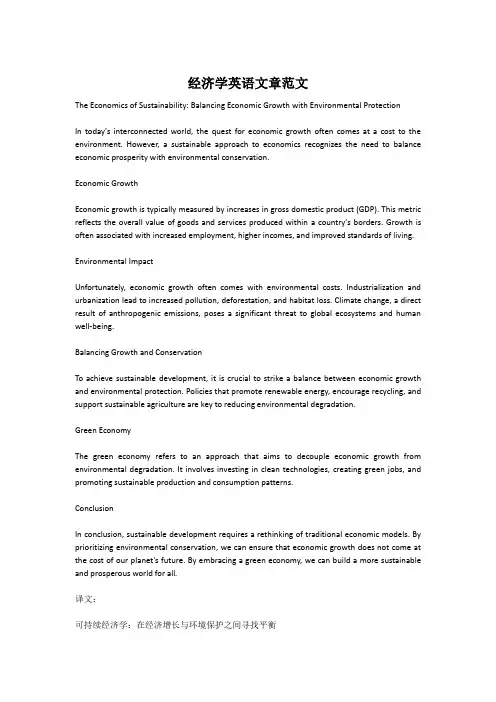
经济学英语文章范文The Economics of Sustainability: Balancing Economic Growth with Environmental ProtectionIn today's interconnected world, the quest for economic growth often comes at a cost to the environment. However, a sustainable approach to economics recognizes the need to balance economic prosperity with environmental conservation.Economic GrowthEconomic growth is typically measured by increases in gross domestic product (GDP). This metric reflects the overall value of goods and services produced within a country's borders. Growth is often associated with increased employment, higher incomes, and improved standards of living.Environmental ImpactUnfortunately, economic growth often comes with environmental costs. Industrialization and urbanization lead to increased pollution, deforestation, and habitat loss. Climate change, a direct result of anthropogenic emissions, poses a significant threat to global ecosystems and human well-being.Balancing Growth and ConservationTo achieve sustainable development, it is crucial to strike a balance between economic growth and environmental protection. Policies that promote renewable energy, encourage recycling, and support sustainable agriculture are key to reducing environmental degradation.Green EconomyThe green economy refers to an approach that aims to decouple economic growth from environmental degradation. It involves investing in clean technologies, creating green jobs, and promoting sustainable production and consumption patterns.ConclusionIn conclusion, sustainable development requires a rethinking of traditional economic models. By prioritizing environmental conservation, we can ensure that economic growth does not come at the cost of our planet's future. By embracing a green economy, we can build a more sustainable and prosperous world for all.译文:可持续经济学:在经济增长与环境保护之间寻找平衡在当今紧密相连的世界中,追求经济增长往往以环境为代价。
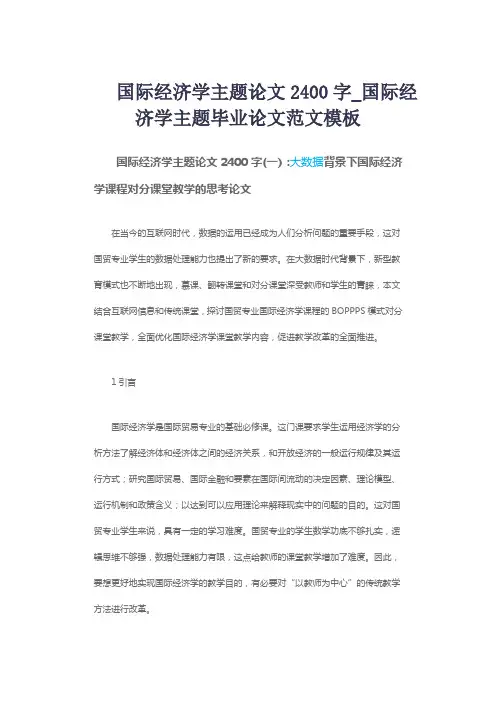
国际经济学主题论文2400字_国际经济学主题毕业论文范文模板国际经济学主题论文2400字(一):大数据背景下国际经济学课程对分课堂教学的思考论文在当今的互联网时代,数据的运用已经成为人们分析问题的重要手段,这对国贸专业学生的数据处理能力也提出了新的要求。
在大数据时代背景下,新型教育模式也不断地出现,慕课、翻转课堂和对分课堂深受教师和学生的青睐,本文结合互联网信息和传统课堂,探讨国贸专业国际经济学课程的BOPPPS模式对分课堂教学,全面优化国际经济学课堂教学内容,促进教学改革的全面推进。
1引言国际经济学是国际贸易专业的基础必修课。
这门课要求学生运用经济学的分析方法了解经济体和经济体之间的经济关系,和开放经济的一般运行规律及其运行方式;研究国际贸易、国际金融和要素在国际间流动的决定因素、理论模型、运行机制和政策含义;以达到可以应用理论来解释现实中的问题的目的。
这对国贸专业学生来说,具有一定的学习难度。
国贸专业的学生数学功底不够扎实,逻辑思维不够强,数据处理能力有限,这点给教师的课堂教学增加了难度。
因此,要想更好地实现国际经济学的教学目的,有必要对“以教师为中心”的传统教学方法进行改革。
BOPPPS模式教学法有六大教学结构,分别是导言(Bridge-in)、学习目标(Objective/Outcome)、前测(Pre-assessment)、参与式学习(Participat oryLearning)、后测(Post-assessment)和总结(Summary)。
导言的作用是为了吸引学生的注意力和提高学生的学习兴趣,让学生知晓课程主题和重要性。
学习目标要从学习者的角度出发,明确、适当、可达成、可测量,涉及认知、技能和情意等三方面目标。
前测的作用是了解学生的知识储备情况及学生的兴趣,调整后续的难易与进度,让课程的目标更加聚焦。
参与式学习的目的在于让主动学习、深入思考、强化印象,要以学生为中心,抛弃传统的以教师为中心的教学。
经济学小论文英文翻译The concept of supply and demand is a fundamental principle in economics. When the demand for a product or service increases, while the supply remains constant, the price of that product or service increases. Conversely, when the demand for a product or service decreases, while the supply remains constant, the price decreases.Supply and demand are influenced by a variety of factors, including consumer preferences, changes in the cost of production, and changes in the availability of resources. For example, if the cost of producing a good increases, the supply of that good may decrease, leading to an increase in price. On the other hand, if consumers' preferences shift towards a particular product, the demand for that product may increase, leading to an increase in price.In a competitive market, the interaction of supply and demand leads to an equilibrium price, where the quantity supplied equals the quantity demanded. This equilibrium price is determined by the intersection of the supply and demand curves. If the market is not in equilibrium, there will be either a surplus or a shortage of the product, which will lead to changes in price.Understanding the dynamics of supply and demand is crucial for businesses, policymakers, and consumers. Businesses must carefully consider the factors that influence supply and demand in order to make informed production and pricing decisions. Policymakers must also consider the impact of their decisions on supply and demand in order to avoid unintended consequences.Finally, consumers must be aware of how changes in supply and demand can affect the prices of the products and services they purchase.In conclusion, supply and demand are essential concepts in economics that have a profound impact on the prices of goods and services. By understanding the factors that influence supply and demand, businesses, policymakers, and consumers can make more informed decisions.Supply and demand also play a crucial role in shaping the overall economy. When the demand for goods and services is strong, it can lead to increased production, investment, and employment opportunities, ultimately contributing to economic growth. Conversely, a decrease in demand can result in lower production, reduced investment, and potential unemployment, which can have negative ripple effects throughout the economy.Moreover, the concept of elasticity is important in understanding how changes in price and quantity affect supply and demand. Price elasticity of demand measures how sensitive the quantity demanded is to changes in price, while price elasticity of supply measures how sensitive the quantity supplied is to changes in price. When demand is price elastic, a small change in price can result in a large change in quantity demanded, whereas when demand is price inelastic, a change in price has a relatively small impact on quantity demanded.Similarly, the elasticity of supply is crucial in determining how producers respond to changes in price. In the case of price elastic supply, producers can quickly increase or decrease the quantitysupplied in response to changes in price. In contrast, when supply is price inelastic, producers may find it challenging to adjust the quantity supplied in response to price changes.Understanding these concepts allows businesses to better predict consumer behavior and make adjustments to their production and pricing strategies accordingly. It also enables policymakers to design effective economic policies, such as taxes or subsidies, to influence supply and demand in certain markets.In addition, international trade is another area where supply and demand dynamics have significant implications. Changes in supply or demand in one country can have spillover effects on the global market, impacting prices and trade flows across borders.In conclusion, the principles of supply and demand are fundamental to the functioning of economies at both micro and macro levels. The interplay between these forces determines prices, production levels, and overall economic activity. Therefore, a comprehensive understanding of supply and demand is essentialfor businesses, policymakers, and individuals in making informed decisions and comprehending the complexities of the economic world.。
The green barrier to free tradeC. P. ChandrasekharJayati GhoshAs the March 31 deadline for completing the "modalities" stage of the proposed new round of negotiations on global agricultural trade nears, hopes of an agreement are increasingly waning. In this edition of Macroscan, C. P. Chandrasekhar and Jayati Ghosh examine the factors and the players constraining the realisation of such an agreement.AT THE END of the latest round of meetings of the agricultural negotiations committee of the WTO, the optimism that negotiators would meet the March 31 deadline for working out numerical targets, formulas and other "modalities" through which countries can frame their liberalisation commitments in a new full-fledged round of trade negotiations has almost disappeared. That target was important for two reasons.First, it is now becoming clear, that even more than was true during the Uruguay Round, forging an agreement in the agricultural area is bound to prove extremely difficult.Progress in the agricultural negotiations was key to persuading the unconvinced that a new `Doha Round' of trade negotiations is useful and feasible.Second, the Doha declaration made agricultural negotiations one part of a `single undertaking' to be completed by January 1, 2005. That is, in a take `all-or-nothing' scheme, countries had to arrive at, and be bound by, agreements in all areas in which negotiations were to be initiated in the new round. This means that if agreement is not worked out with regard to agriculture, there would be no change in the multilateral trade regime governing industry, services or related areas and no progress in new areas, such as competition policy, foreign investment and public procurement, all of which are crucial to the economic agenda of the developed countries.The factors making agriculture the sticking point on this occasion are numerous. As in the last Round, there is little agreement among the developed countries themselves on the appropriate shape of the global agricultural trade regime.There are substantial differences in the agenda of the US, the EU and the developed countries within the Cairns group of agricultural exporters. When the rich and the powerful disagree, a global consensus is not easy to come by.But that is not all. Even if an agreement is stitched up between the rich nations, through manoeuvres such as the Blair House accord, getting the rest of the world to go along would be more difficult this time.This is because the outcomes in the agricultural trade area since the implementation of the Uruguay Round (UR) Agreement on Agriculture (AoA) began have fallen far short of expectations. In the course of Round, advocates of the UR regime had promised global production adjustments that would increase the value of world agricultural trade and an increase in developing country share of such trade.As Chart 1 shows, global production volumes continued to rise after 1994 when the implementation of the Uruguay Round began, with signs of tapering off only in 2000 and 2001. As is widely known, this increase in production occurred in the developed countries as well.Not surprisingly, therefore, the volume of world trade continued to rise as well after 1994 (Chart 2). The real shift occurred in agricultural prices which, after some buoyancy between 1993and 1995, have declined thereafter, and particularly sharply after 1997. It is this decline in unit values that resulted in a situation where the value of world trade stagnated and then declined after 1995, when the implementation of the Uruguay Round began.As Table 1 shows, there was a sharp fall in the rate of growth of global agricultural trade between the second half of the 1980s and the 1990s, with the decline in growth in the 1990s being due to the particularly poor performance during the 1998 to 2001 period.Price declines and stagnation in agricultural trade values in the wake of the UR Agreement on Agriculture were accompanied and partly influenced by the persisting regionalisation of world agricultural trade.The foci of such regionalisation were Western Europe and Asia, with 32 and 11 per cent of global agricultural trade being intra-Western European and intra-Asian trade respectively (Chart 3). What is noteworthy, however, is that agricultural exports accounted for a much higher share of both merchandise and primary products trade in North America and Western Europe (besides Latin America and Africa) than it did for Asia.Thus, despite being the developed regions of the world, agricultural production and exports were important influences on the economic performance of North America and Western Europe.It is, therefore, not surprising that Europe is keen on maintaining its agricultural sector through protection, while the US is keen on expanding its role in world agricultural markets by subsidising its own farmers and forcing other countries to open up their markets. The problem is that the US has been more successful in prising open developing country markets than the large EU market.Thus, out of $104 billion worth of exports from North America in 2001, $34 billion went to Asia and $15 billion to Latin America, whereas exports to Europe amounted to $14 billion.The Cairns group of exporting countries (Argentina, Australia, Bolivia, Brazil, Canada, Chile, Colombia, Costa Rica, Guatemala, Indonesia, Malaysia, New Zealand, Paraguay, the Philippines, South Africa, Thailand and Uruguay), for some of whom at least agricultural exports are extremely important, want world market to be freed of protection as well as the surpluses that result from huge domestic support in the US and the EC.We must note that $35 billion of the $63 billion of exports from Latin America went to the US and the EU. More open markets and less domestic support in those destinations is, therefore, crucial for the region.The fact that Europe has been successful in its effort at retaining its agricultural space with the help of a Common Agricultural Policy that both supports and subsidises its agricultural producers is clear from Chart 4, which shows that intra-EC trade which accounted for 74 per cent of EU exports in 1990, continued to account for 73 per cent of total EU exports in 1995 and 2001.But North America, with far fewer countries in its fold, has also been quite insular. Close to a third of North American exports are inter-regional. Little has changed since the Uruguay Round Agreement on Agriculture.It is widely accepted that three sets of actors account for this failure of the AoA:First, in order to push through an agreement when there were signs that the Uruguay Round was faltering, the liberalisation of agricultural trade in the developed countries was not pushed far enough;Second, is the ability to use "loopholes", especially those in the form of inadequately well-defined Green and Blue Box measures, in the AoA, to continue to support and protect farmers on the grounds that such support was non-trade distorting; andFinally, there are violations of even the lax UR rules in the course of implementation, which have been aided by the failure of the agreement to ensure transparency in implementation.Not surprisingly, some countries, especially the Cairns group of exporting countries, have proposed an ambitious agenda of liberalisation in the agricultural area.Tariffs are to be reduced sharply, using the "Swiss formula", which would ensure that the proportionate reduction in the tariffs imposed by a country would be larger, the higher is the prevailing bound or applied tariff in that country.中文翻译:题目:自由贸易中的绿色壁垒作者:C. P. Chandrasekhar 、Jayati Ghosh在A完自由化的承诺在其最新一轮会议的农业谈判委员会,世界贸易组织,乐观地认为,谈判的框架将在3月31日最后期限为制定数字指标,公式和其他“方式,哪些国家可以”通过新的全面谈判回合贸易几乎已经消失。
Comparative Advantage and China's economic development Keywords: static comparative advantages of dynamic comparative advantage of China's economic development Abstract: static comparative advantage theory of comparative advantage to be seen as static, unchanging, emphasizes resource endowment established in accordance with leading industry; while the dynamic comparative advantage theory is that comparative advantage is dynamic, changes, emphasizing selective cultivation the new competitive industries. Practice should be based on an existing static comparative advantage to create dynamic comparative advantage, and comparative advantage in order to achieve conversion upgrade industrial structure. I. Introduction The traditional theory of comparative advantage of the comparative advantage seen as static, unchanging, the relative costs include Ricardo and Heckscher said - Ohlin theory of resource endowments. The comparative advantages of the modern emphasis on focusing on industrial policy and foreign trade policy is to support emerging infant industries in order to upgrade and comparative advantages of the conversion of the industrial structure, the comparative advantage as a dynamic, changing, closer to international trade reality. II.The traditional theory of comparative advantage : According to leading industry resource endowment established ( A ) comparative advantage and absolute advantage The concept of comparative advantage and absolute advantage in the corresponding. Absolute advantage in comparison to establish the absolute cost of production on . If the resource is a commodity used in a number of units produced in the country or a higher absolute amount of less efficient , then it has an absolute advantage in the production of this commodity . Brazil, for example, at a lower cost production of coffee and bananas , the United States is able to lower the cost of production of aircraft and close the machine . Thus , Brazil has an absolute advantage in the production of coffee and bananas , the United States in the production of aircraft and close the machine has an absolute advantage . Thus , countries through international trade is difficult for them to get the products : Canada needs to import coffee , Japan needs to import oil , Kuwait needs to import aircraft. Comparative advantage built on the basis of the opportunity cost of production activities on . If a country's opportunity cost of producing a commodity is lower than other countries , the country has a comparative advantage on this production ; Conversely, if a country's opportunity cost of production of a commodity is higher than in other countries , the lack of comparative advantage. As one of the basic theory of economics, comparative advantage is a central proposition : a country , even in the production of each commodity is not an absolute advantage in some areas it will still enjoy comparative advantage ; only their absolute advantage of countries are likely to increase welfare through the exchange , the state has a comparative advantage can also increase welfare through trade . (B ) the traditional theory of comparative advantage The first explanation is not only absolute advantage and comparative advantage can also become a source of business people , is an early 19th century British classical economist David Ricardo . He needed only under the assumption of a factor of production , with a brief description of a few figures to illustrate this principle . Early 20th century, the Swedish economist Heckscher - Ohlin role in considering a variety of factors , based on the re- expression of the principle of comparative advantage , comparative advantage that the decision factors, the most important is the factor endowments . Element is to play a role in the production process of various tangible and intangible factors, such as natural resources, intellectual capital , physical capital , land, skilled and unskilled labor , etc. endowment refers to a country (or region ) actually have elements of total volume and structure. The production of a product or industry whether the activities have a comparative advantage , depending on their ability to more intensive use of the country's relatively abundant factor , depending on whether the proportion of the cost of their production in line with the country's structure. The more energy intensive use of elements of a country's abundant production project , the more have a
A qualitative study of business-to-businesselectronic commerce adoption within the Indonesian grocery industry: A multi-theory perspectiveAbstractThis study explores the business-to-business electronic commerce (B2B EC) technology adoption experience of organizations within the supply chain of the grocery industry in Indonesia using a multi-theory perspective. Through amultiple case study with eight organizations, it provides a comprehensiveunderstanding of the influence of adoption factors. This study shows theusefulness of complementarily deploying several adoption theories and offers important theoretical and practical implications for organizations as theyextend their supply chains globally.Keywords•Electronic commerce;•Technology adoption;•Grocery industry;•Developing country;•Supply chain management;•Qualitative study1. IntroductionElectronic Commerce (EC) is a broad concept that refers to the exchange of products/services and information via computer networks, including theInternet, Extranet and Intranet . Within the B2B EC context, a diverse range of technologies and initiatives have been introduced. Examples of technologies include Electronic Data Interchange (EDI), automatic product identification (barcode, RFID tags), and Electronic Funds Transfer, and examples ofinitiatives include cross docking, Vendor Managed Inventory (VMI),Continuous Replenishment Program (CPR), and Collaborative Planning,Forecasting and Replenishment (CPFR) . Organizations can obtain substantial benefits from their investment in EC technologies, as EC generally enables organizations to improve reach, richness and affiliation . Due to the potential of EC, many countries worldwide have rapidly adopted it , resulting in asignificant growth of EC in developed countries during the last two decades and, more recently, in developing countries .In the era of globalization, developing countries have played an important role in world trade and commerce because of their large market potential and low cost of labor . Developing countries are defined as countries with a low to middle income level, a low standard of living, restricted technology infrastructure and limited access to products and services . With advancements in information and communication technologies (ICT), large global organizations are increasingly extending their supply chains across multiple continents in order to cut costs and increase their reach . Through ICT adoption, developed countries can trade with developing countries more efficiently and, in turn, help those developing countries achieve more sustainable economic growth.However, due to differences in their social, cultural, economic, political, legal and technological conditions, developing countries encounter a set of problems and concerns that vary considerably from those faced by developed countries For example, Hofstede's national culture theory suggests that developing countries and developed countries differ greatly in their characteristics, which may affect their organizational behavior toward technology adoption . Cultural differences captured by Power Distance and Uncertainty Avoidance dimensions suggest that organizational technology adoption behavior is constrained socially as a result of the attachment of meanings and interpretations relevant to that cultural context. Thus, organizations operating in developed countries (with a low Uncertainty Avoidance index) tend to stress both technological development and technological adoption more than organizations operating in countries with a high Power Distance and low tolerance for ambiguity and uncertainty . In another study, Guo et al. find that the way organizations use e-mail, phone and fax in China (a developing country) and Australia (a developed country) is largely influenced by the difference in the Uncertainty Avoidance dimension of cultural difference between these two nations. As a result, different sets of approaches to technology adoption are required to suit the cultural and contextual conditions of developing countries .However, at this stage, there remains a relatively limited number of in-depth studies and understanding regarding the adoption of EC technologies by developing countries, despite a growing number of technology penetrations that have taken place in these countries in recent years An understanding of the adoption of ICT, in particular EC technology, by developing countries isthus important for both researchers and practitioners. Moreover, the contextual situations of countries are arguably different in nature. For example, the maturity of the ICT infrastructure, e-commerce readiness, degree of government support, and extent of business competitiveness vary greatly, not only between the developed and developing countries but also among developing countries. Furthermore, it would be inappropriate to assume that various dimensions of national culture remain somewhat similar across all developing countries. In fact, distinct cultural differences are noted among developing countries. Hence, it could be argued that qualitative studies focusing on e-commerce adoption in some developing countries are not necessarily reflective of the e-commerce trends and adoption dynamics of all developing countries across the globe.In addition, some noticeable gaps have been identified in the existing EC literature. First, in the context of developing countries, there are limited empirical studies on EC technology adoption by large organizations. By contrast, many studies explore the diffusion of EC technologies among small and medium-sized enterprises (SMEs), primarily using surveys. Second, most of these studies, especially in the Southeast Asia region, explore only general EC technology and practices (including Business-to-Customers EC and general e-mail practices). Only a handful of studies assess a broad range of EC technologies such as EDI, e-auctions, EFT, and other B2B EC initiatives . Furthermore, due to the exclusion of the study context, there have been some conflicting findings regarding the impact of adoption factors on actual adoption . In addition, several existing studies aggregate the adoption experience across multiple industries within a country using quantitative methods. Therefore, a detailed understanding of organizations’ adoption experience is lacking . Only a few authors focus on a specific industry and employ a qualitative method, for example, Utomo and Dodgson , who concentrate on Indonesia's manufacturing of industrial products, and Kurnia , who focuses on the Chinese grocery industry. The existing qualitative studies on EC adoption are also generally descriptive in nature. Typically, they identify a number of adoption factors, which are often grouped into technological, organizational and environmental contexts but generally lack theoretical explanations of the underlying mechanisms of the influence.Thus, in summary, we argue that there is currently a lack of rich understanding of the B2B EC adoption phenomenon in developing countries due to the dominance of quantitative studies and the limited application of adoption theories . In fact, the adoption process involves dynamic interactions amongsocial, legal, economic, political and technological factors that call for more studies involving several theoretical perspectives to better understand the adoption phenomenon in different contexts of developing countries. Each developing country may have specific contextual factors involving different dynamics and interplays, which may have differing effects on the adoption phenomenon. In-depth studies of how B2B EC technology is adopted in a context that has not yet been thoroughly investigated thus contribute to the current knowledge in this area.2. Overview of the Indonesian grocery industryIndonesia has many natural resources, and its economic position has developed rapidly. The Indonesian economy is ranked 16th on a global scale based on GDP, and its purchasing power is ranked 15th. Indonesia has been an important trading partner for many countries, including China, India, Australia and many other developed nations . In particular, foreign retailers quite naturally seek to develop a presence in any country with a large population base. In addition, given years of continuous impressive and sustained economic growth in Indonesia during the 1990s, the grocery industry presented tremendous potential for future growth in the eyes of foreign retailers .Strong growth in Indonesians’ personal disposable income has led to steady escalation in grocery retail sales since the end of the 20th century. This reflects a substantial increase in the minimum wage, high inflation rates, and recovery from the 1998 crisis. Indonesia is viewed as a market that is closely associated with continuous economic recovery and steady adoption of consumerism. In 2002, retail sales in Indonesia amounted to nearly US$ 7 billion, and the sector employed approximately 17.7% of Indonesian's total labor. In 2012, grocery retail sales in Indonesia amounted to approximately US$ 36 billion and are estimated to increase to US$ 64 billion by 2016 . These figures show the potential impact of the grocery industry on Indonesia's overall economic situation for years to come.The current Indonesian grocery retail market can be divided into the traditional market format, which includes traditional stores and wet markets, and the modern market format, which includes mini markets (convenience stores), supermarkets, and hypermarkets. In urban areas, the high concentration of different retail types has intensified competition. Hypermarkets, with their large product offerings of approximately 60,000 items, are strongly competing with supermarkets for market share, and both are in tight competition with thetraditional market format. The traditional market format, however, continues to dominate the rural market, where competition is much less intense .In the last five years, the modern market format has been the fastest mover in the modern grocery retail sector in Indonesia. During the period of 2004–2008, the modern market grew by as much as 19.8% per year, the highest among the retail types . Supermarkets continued to have the largest share of the modern market up until 2004, with up to 42.5% of the total market share. However, since 2005, the Indonesian modern market has been dominated by hypermarkets, which are the most profitable type of modern market. In 2008, supermarkets accounted for only 26.2% of the market share, following hypermarkets, which had 41.7% of the market share, and minimarkets, with a 32.1% share . Of the three different types of modern market formats, the hypermarket is predicted to be the strongest retail model for the next 5 years. The hypermarket, also well known as Mass Grocery Retail (MGR), is estimated to grow from the starting position of US$ 2.4 billion revenue in 2008 to US$ 3.9 billion in 2013 . The influence of these modern market formats and MNC has generally driven technology adoption within the industry.3. The study findingsIn this section, we describe how the adoption factors captured in our research framework drive or inhibit the adoption of various B2B EC technology initiatives currently adopted by the organizations involved in our study. Table4 summarizes factors affecting the adoption of B2B EC by the participants. Each factor is discussed below.3.1. Technological contextWithin the technological context, the study findings highlight three salient factors that affect adoption: perceived benefits, compatibility and cost of technologies. Each factor has a different influence on EC adoption. Other characteristics, such as complexity and risks, do not appear to significantly affect the B2B EC adoption by the participants and, hence, are not discussed in this section.3.1.1. (+) Perceived benefitsWithin the technological context, our study indicates the positive influence of the perceived benefits of the adopted B2B EC technologies. Most organizations find that this is a very crucial factor in every technology initiative that they decide to pursue. Some of these perceived benefits include accuracy,speed and efficiency, which all finally lead to cost savings for the organizations. These benefits are the main drivers behind the pursuit of B2B EC initiatives such as barcode, EDI, and cross docking. B2B EC initiatives such as the handheld PDA system are perceived to have additional benefits. Apart from speed and efficiency, participants acknowledged other benefits of implementing these initiatives, including the following: (1) ability to control and monitor human factors, imposing discipline and strict policy to ensure a sufficient level of salesmen performance, (2) ability to increase information visibility for both its own employees and external customers, and (3) ability to maintain good relationships with trading partners by maintaining face-to-face interactions. According to the Managing Director, Manufacturer (Company C):We need to do things more efficiently and faster. Automation [theuse of PDA] reduces human errors, which results in efficiencyand speed, leading to more sales. It increases our speed ofprocessing data. Also, it helps to control and impose disciplineon our salesmen. We can track down all their activities in thefield.Managing Director, Manufacturer (Company C)As technology adoption would typically require substantial investment capital, it is very important for organizations to foresee the perceived benefits to be gained from such an investment.。
Comparative AdvantageⅠ. IntroductionA person has a comparative advantage in an activity if that person can perform the activity at a lower opportunity cost than anyone else. Let’s explore the idea of comparative advantage by looking at a gardening story.Ⅱ. StudySuppose it is early spring and it is time to prepare the family backyard garden for the first planting of the year. The father in the household sets aside one Sunday afternoon to do the job but hopes to complete the job as quickly as possible. Preparation of the garden requires the following tasks. First, the soil must be turned over and broken up using the roto-tiller, then the soil must be raked and smoothed. Finally, seeds must be planted or sowed.This year the father’s 7-year-old son is anxious to help. The question at hand is whether the son should be allowed to help if one’s only objective is to complete the task in the shortest amount of time possible.At first thought, the father is reluctant to accept help. Clearly each task would take the father less time to complete than the time would take the son. In other words, the father can perform each task more efficiently than the son. The father estimates that it will take him 3 hours total to prepare the garden if he works alone and each task needs 1 hour, as shown in the following table.On second thought, the father decides to let his son help according to the following procedure. First the father begins the roto-tilling. Once he has completed half of the garden, the son begins raking the roto-tilled section while the father finishes roto-tilling the rest of the garden plot. After the father finishes roto-tilling the beginsplanting seeds in the section the son has already raked. Suppose the son rakes slower than the father plants, and that the father completes the sowing process just as the son finishes raking. Note this implies that raking takes the son almost 2 hours compared to one hour for the father. However, because the son’s work is done simultaneously with the father’s work, it does not add to the total time for the project. Under this plan the time needed to complete the tasks is only 2 hours, as shown in the following table.Notice that the total time needed to prepare the garden has fallen from 3 hours to 2 hours. It makes sense to employ the son in production even though the son is less efficient than the dad in every one of the three required tasks. Overall efficiency is enhanced when both resources (the father and the son) are fully employed. However, it is important to allocate the tasks correctly between the father and the son. Suppose the father allowed his son to do the roto-tilling instead, in this case the time needed for each task might look as follows.This highlights the importance of specializing in production of the task in which you have a comparative advantage. Even though the father can complete all three tasks quicker than his son, his relative advantage in roto-tilling greatly exceeds his advantage in raking and planting. One might say that the father is mist-best at roto-tilling while he is least-best at raking and planting. On the other hand, the son is least-worse at raking and planting but most-worse at roto-tilling. Finally, because of the sequential nature of the tasks, the son can remain fully employed only if he workson the middle task, namely raking.Ⅲ. ConclusionThe garden story offers an intuitive explanation of comparative advantage.In today’s world, by discovering your comparative advantage, you will be able to focus on producing the items that make you as well off as possible. Think hard about what you ehjoy doing and that you do comparatively better than others. That, most likely, is where your comparative advantage lies. It is good idea to try to remain flexible so that you can switch jobs if you discover that your comparative advantage has changed.。
如何学好经济学的英语论文IntroductionEconomics is a complex and multifaceted subject that deals with the production, distribution, and consumption of goods and services. It is a social science that examines how individuals, businesses, and governments make decisions and allocate resources. Studying economics can be challenging, but with the right approach and mindset, you can master this discipline. In this essay, we will discuss some effective strategies for studying economics and achieving academic success in this field.1. Understand the BasicsBefore delving into more complex topics in economics, it is essential to have a strong grasp of the fundamental principles. This includes understanding concepts such as supply and demand, opportunity cost, and the circular flow of income. Familiarize yourself with the basic laws of economics, such as the law of diminishing marginal utility and the law of supply and demand. These foundational concepts form the building blocks of economic theory and will provide you with a solid framework for understanding more advanced topics.2. Develop Strong Analytical SkillsEconomics is a discipline that requires strong analytical skills. To excel in this field, you must be able to think critically, interpret data, and draw meaningful conclusions. Practice solving problems and analyzing economic data to hone your analytical abilities. Develop the habit of breaking down complex issues into smaller, more manageable parts and identifying key factors that influence economic outcomes. By developing strong analytical skills, you will be better equipped to understand economic phenomena and make informed decisions.3. Stay Updated on Current EventsEconomics is a dynamic field that is constantly evolving. Stay informed about current economic trends, political developments, and global events that impact the economy. Reading reputable newspapers, journals, and online sources can help you stay abreast of the latest economic news and developments. By understanding how real-world events influence economic outcomes, you will be able to apply theoretical concepts to practical situations and enhance your understanding of economic theory.4. Utilize Multiple ResourcesIn addition to your textbooks and lecture notes, make use of a variety of resources to enhance your understanding of economics. This includes online lectures, academic journals, research papers, and study guides. Seek out additional reading materials and resources that cover different perspectives and approaches to economic theory. Engage with online forums and discussion groups to exchange ideas and learn from others who are studying economics.By utilizing multiple resources, you can gain a more comprehensive understanding of economic concepts and theories.5. Practice Problem-SolvingEconomics is a practical discipline that requires problem-solving skills. Practice solving economic problems and analyzing hypothetical scenarios to improve your problem-solving abilities. Work through practice exercises and sample problems to strengthen your grasp of economic concepts and principles. Seek feedback from professors, tutors, or classmates to identify areas where you can improve and refine your problem-solving skills. By practicing problem-solving regularly, you will become more proficient at applying economic theory to real-world situations.6. Participate in Discussions and DebatesEngaging in discussions and debates with your peers can help deepen your understanding of economic concepts and theories. Participate in class discussions, group projects, and debates to exchange ideas, challenge assumptions, and explore different perspectives on economic issues. By actively engaging with your peers, you can gain new insights, broaden your horizons, and develop a more nuanced understanding of economic theory. Additionally, participating in discussions and debates can improve your communication skills, critical thinking abilities, and ability to articulate complex ideas effectively.7. Seek Help When NeededIf you encounter difficulties or challenges while studying economics, do not hesitate to seek help. Reach out to your professors, academic advisors, or tutors for assistance and guidance. Attend office hours, review sessions, or study groups to clarify concepts, ask questions, and seek feedback on your work. Utilize online resources, tutoring services, or study aids to supplement your learning and address areas where you may be struggling. By seeking help when needed, you can overcome obstacles, improve your understanding of economics, and achieve academic success in this field.ConclusionStudying economics can be a rewarding and fulfilling experience if approached with the right mindset and strategies. By understanding the basics, developing strong analytical skills, staying updated on current events, utilizing multiple resources, practicing problem-solving, participating in discussions and debates, and seeking help when needed, you can enhance your understanding of economic concepts and theories. With dedication, perseverance, and a passion for learning, you can excel in the field of economics and make meaningful contributions to our understanding of the economy and society.。
Modern Logistics in the international economic Thesis: logistics Class: Class one logistics Name: Xiaonan Zhao Student ID : 121703068 I Abstract: Modern Logistics, a new type of integrated type management, refers to send information, transportation, and storage, loading/unloading, packing and other Logistics activities together. Its task is to reduce the total cost of Logistics, to provide customers with the best service. However, many national experts have said: "Modern Logistics is a process to make goods transfer from supplying place to local requirement according to the demand of customers in the lowest economic costs. It mainly includes transportation, storage, processing, packing, loading and unloading, distribution and information processing and other activities.”
Factors affecting the purchase price includes 5 aspects: the cost of materials. the relationship between supply and demand. seasonal changes. market environment. delivery conditions.
When the social productivity ascending to a degree then to reduce production cost becoming more difficult, reduce logistics cost for products provide a certain profit space. This also makes the modern logistics has very good development prospect. This article will unfold from all parties to analyze modern logistics below.
II Keywords: Modern logistics Transportation Logistics packing Warehouse management Storage
III Contents Part One: Transportation Part Tow: Storage Part Three: Loading and unloading Part Four: Logistics packing Part Five: Distribution IV Test Part One: Transportation Logistics is the core of modern logistics business, and is the obbligato part of logistics operation and management as well. Although transport process does not produce new material products, but it can realize logistics space utility and time utility. It is around by the other logistics activities. And that transportation cost is very large proportion in logistics cost, so the transportation rationalization is the key to rationalize logistics system. Transportation service is provided by the combination of various providers, including single way operator, professional carrier, transport operator and the homework properties of middlemen. The modern transportation means include railway transport and road transportation, waterway transport and air transport, and pipeline etc. In practical applications, in order to realize the optimization it can speak different modes of transportation together according to various needs. The main area of change in organizational strategy is the extensive use of third party logistics providers who are using advanced information technology tools and integration of supply chain to enhance customer satisfaction. By outsourcing the logistics operations,companies can focus on their core competencies and other important areas of organization which can’t be outsourced. The analysis of this paper is conducted by discussing different concepts of supply chain integration, customer satisfaction, advanced information technology and third party logistics providers, and their impact on customer satisfaction with theoretical framework. An analytical model is also presented.
Part Two: Storage As a result of the unceasing increase of production size, storage have become an important and indispensable part of organizations. The thing flows the technology is the product which the modern science and technology and the industrial development unifies, the automation flows the management system management system is the spotlight, machine, the electricity, the meter is a body systems engineering. This system mainly has: Automated multi-layered storehouse (AS/RS), automatic expulsion system, homing control vehicle (AGV) system, computer management and simulation, simulation system, system integration and logic control system. Involves the domain includes: Artificial intelligence, pattern recognition, computer simulation, computer simulation, wireless communication, infrared communication, laser location technology, electromagnetism guiding, inertial navigation technology and so on.
The automation flows use the computer control the management system completely. The computer basis massive thing flow the information, the data, the image and each kind of instruction carry on the input output, the structure which the reflection flows, flow to, the current capacity, the reserve, the thing flow the expense and so on. This system can rapid be accurate, the integrity collection, the transmission, the storage, processing and each kind of fluxion according to, can promptly understand and grasp the thing to flow the advancement, the correct decision-making, coordinates various links, effectively computation and organization commodity circulation.